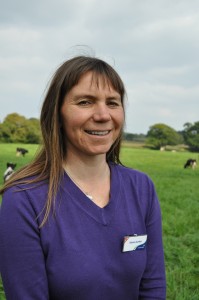- November 13th, 2014
- /
- Dave Richards
- /
- 0 Comments
- /
- Open Day reveals how grassland productivity was improved at Ridgend Farm

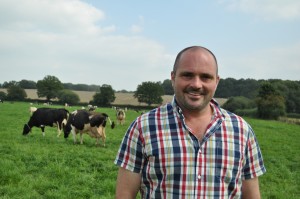 For the past three years, the Grassright Group has been working with Worcestershire dairy farmer Dave Richards of Ridgend Farm to improve the productivity ofhis grassland, with a particular focus on silage leys.
For the past three years, the Grassright Group has been working with Worcestershire dairy farmer Dave Richards of Ridgend Farm to improve the productivity ofhis grassland, with a particular focus on silage leys.
At an Open Day in September, farmers learnt how Dave is now enjoying the benefits of faster-growing, denser swards through changing his policies and practices. He has adopted a number of different management techniques and routines, and Grassright Group members: GrowHow’s Elaine Jewkes, Limagrain’s John Spence and OPICO’s Nick Rider were on hand to explain what had been recommended and why.
Field inspections
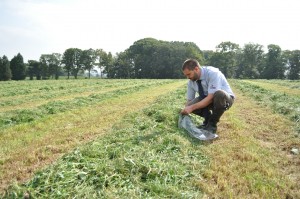 Limagrain’s John Spence recommended that farmers walk their fields at least once a year and assess the ground cover, and also look at the sward itself and identify the relative proportions of ryegrasses, clovers and broadleaved weeds.
Limagrain’s John Spence recommended that farmers walk their fields at least once a year and assess the ground cover, and also look at the sward itself and identify the relative proportions of ryegrasses, clovers and broadleaved weeds.
The details of the assessments can be recorded on Field Inspection sheets.
“Having assessed all the grassland, and knowing what your plans are for cropping the following year, decisions can then be made as to which fields to target for improvement first. Farmers should look at the potential return on investment rather than just the need to reseed,” said John.
Reseeding and overseeding
John explained the reasons why reseeding was important: “Over time, leys suffer a drop in both yield and quality: the sown species of productive grasses decline, plant vigour declines, and weed grass populations increase.”
At Ridgend Farm, the high yielding cows are being kept housed, and so the priority has been to improve production and quality from the silage leys.
John advised that when reseeding, the choice of mixture to sow needs to be based on whether the field will be used as a grazing or cutting field, and also the intended length of time that the ley will be down.
He explained: “Long term ley mixtures will contain varieties selected for their persistency rather than their yields. Conversely, short-term ley mixtures will contain varieties which are high yielding in dry matter and quality, but these grasses do not persist. It’s always a trade-off. What is important,is to select a mixture that is ‘fit for purpose’.”
Dave had sown a 2-year Italian ryegrass mixture- Maxiyield- in his silage fields, but now it was time to reseed and the mixtures Hymax or Polycrop were to be sown. These would last for five years, which meant they fitted well into the rotation.
John also said farmers should ensure that they only bought seed mixtures which included recommended varieties. Another aspect to consider was seed quality: this is shown on the bag label as ‘high voluntary standard’.The higher the quality, the fewer the weed seeds, and the better the germination of the grass seeds.
He went on to explain that the feed quality of grass varieties has also become easier to evaluate with the advent of new technologies such as NIRS (Near Infra-Red Spectrometry). Limagrain is now able to make in-field assessments of quality parameters: protein, sugars, DNDF (fibre) as well as overall plant digestibility (D value) and Metabolisable Energy.
John said: “There can be a 10% difference in parameters between different varieties, each has both strengths and weaknesses – there’s no such thing as a perfect variety! For example, ryegrass varieties which are high in sugars tend to be low in protein. The key is to ensure the mixtures sown have been balanced for both energy – from sugars and fibre – and protein. This is the formulation approach behind Limagrain’s new LGAN range.”
He summed up with the advice: “Know what you’ve got in the field, it’s essential for making the right decisions.
“Reseeding is an investment, it costs money to do, but it will bring down your forage costs – so it is the key to profitability. Always used recommended varieties, and choose seed mixtures fit for your purpose, and formulated for feed quality as well as the agronomic characters such as DM yields and disease resistance.”
Soil testing identifies nutrient shortfalls
Elaine Jewkes of GrowHow told farmers: “It all starts in the soil –you’ve got to know what you’ve got before you
start putting fertiliser on it.”
When the Grassright project began, there wasn’t a full suite of up-to-date soil analyses, so GrowHow started out to sample one third of the farm each year in order to build up the full picture.
One of the main reasons Dave wanted some help from the Grassright Group was that he had experienced some disappointing silage yields and blamed himself for skimping on nitrogen fertiliser.
The soil tests showed that the silage fields – which tended to be those further away from the main farm – were in fact short of phosphorous – with P indices as low as 0 or 1, instead of the target of 2. However, the fields closer to the farm (and where it was much easier to take slurry to), tended to be high in P and K.
GrowHow has now completed sampling the whole farm, taking account of all the crops grown, including the maize, wheat, and barley. Across the farm,pH levels have generally been good – most fields being in the range 6.5 to 7.0.
Elaine explained: “So the main focus has been on raising the P index in the far-off fields, by encouraging Dave to get slurry out to those fields. He also applied MAP in spring to help raise the index.
“It’s cheaper to maintain a soil index at the right level, than to attempt a quick fix when it has fallen. Not only is it costly to load phosphorous onto a field, but there’s also an environmental risk from soil erosion over the winter.”
“In silage leys, the aim is quality as well as DM yield. Sulphur is a critical nutrient these days: it used to be deposited from the atmosphere by emissions from diesel fuels and industry, especially power stations. But thanks to the Clean Air Act, there is now less sulphur pollution in the atmosphere. Sulphur is a component of some of the amino acids which in turn are the building blocks for protein. So improving sulphur levels in the soil will make nitrogen applications more efficient and boost yields.
Elaine also explained that weed grasses do not need high levels of nutrients. So where soil fertility is poor they can thrive, and will out compete the rye grasses.
Elaine, and GrowHow regional farm adviser Ross Leadbeater have been helping Dave to target his fertiliser applications using GrowHow’s nutrient management programme,Encompass. Elaine explained: “This is, in effect, a budgeting package. It allows you to see the nutrient balance, and whether the index is being maintained or raised. Crop off takes are factored in to the recommendation, and the package calculates whether the applications are compliant with NVZ regulations. Application rates of slurry and bought-in fertiliser can then be calculated by an agronomist, using RB209 and some of their own experience, using the soil test result as the starting point.”
Dave now receives a folder with comprehensive nutrient recommendations for the cropping across the whole farm, including a spreading plan for each field. So he is using nutrients in the most cost-effective way – applying them in the amounts needed to support yields, and only purchasing the nutrients required.
Elaine added: “A soil test costs around £12, yet the information it gives has enormous benefits.”
Dave admitted: “I have totally changed my mindset on fertilisers. At the start of the project, I couldn’t see why I needed GrowHow to come and sell me fertiliser! But now I wouldn’t want to be without them! Each year, more fields are tested, and I sit down with Ross and say what crops I’m planning to put where, and he uses Encompass to see what the nutrient requirements are going to be, and how I can use my own farm-yard slurry and top-up the shortfalls with granular fertiliser.”
After three years, the benefits of this strategy are clear: overall DM yields have gone up, and sward re-growth is faster.
Dave added: “And I’m not spending any more on fertiliser than I was before!”
Elaine added: “Like any task, you need to look at what you’ve got, and what you are trying to achieve.”
Checking for compaction
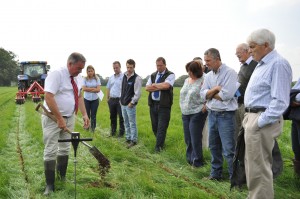 OPICO’s Nick Rider showed farmers how to remove compaction using an OPICO Sward-Lifter. After subsoiling a stretch of ground with the machine, he took out a spade and demonstrated how the condition of the soil structure had changed.
OPICO’s Nick Rider showed farmers how to remove compaction using an OPICO Sward-Lifter. After subsoiling a stretch of ground with the machine, he took out a spade and demonstrated how the condition of the soil structure had changed.
He explained that the settings of the subsoiler legs were important – they were set at a certain distance apart to ensure that sections of ground would remain firm thus preserving the overall structural integrity of the field and preventing ‘slumping’.
He showed farmers how to tell the difference between compacted and un-compacted ground by digging a hole and removing a sod of earth to examine. Signs of compaction included a musty smell and rust-coloured soil particles, and when the sod was dropped onto the ground, it would shatter along horizontal fissures.
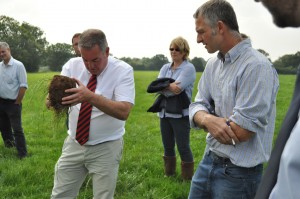 Nick explained: “Signs of a soil profile which is in good physical condition are the presence of earthworms, the soil particles are looser, and when dropped onto the ground the sod has vertical fissures.
Nick explained: “Signs of a soil profile which is in good physical condition are the presence of earthworms, the soil particles are looser, and when dropped onto the ground the sod has vertical fissures.
“The autumn is a good time to assess soil compaction,” explained Nick. “If it’s a depth greater than 15cm, then a sward-lifter will be required to remove it. Shallower compaction can be resolved using a sward-slitter. If it’s possible, get the work done before the winter, so as to avoid water-logging and also to enable fields to dry out and warm up sooner in the spring.”
Harrowing benefits
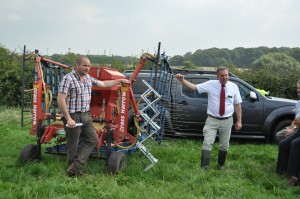 Nick explained that harrowing grassland every spring is very beneficial: “It removes dead plants, mosses and ‘trash’ from the base of the sward. This then allows a better oxygen interchange to the roots, and this stimulates grass growth.”
Nick explained that harrowing grassland every spring is very beneficial: “It removes dead plants, mosses and ‘trash’ from the base of the sward. This then allows a better oxygen interchange to the roots, and this stimulates grass growth.”
Farmers had a variety of options to harrow, and Dave had previously used a chain harrow. Nick showed farmers how the designs of the tines on OPICO’s grass harrow – which included triple windings – created a maximum oscillation on the surface of the ground and how the point pressure could be adjusted so that thatch and shallow-rooted weed grasses could be ripped out.
Early on in the project, the grass harrow had improved growth when used in a silage field where a hard cap of dried slurry had formed on the ground surface, which was then raked up by the tines of the harrow.
Initially, Dave had been loaned the use of a grass harrow, but he had been so impressed with the results, plus the added opportunity to use it for seeding – that he had soon bought his own.


